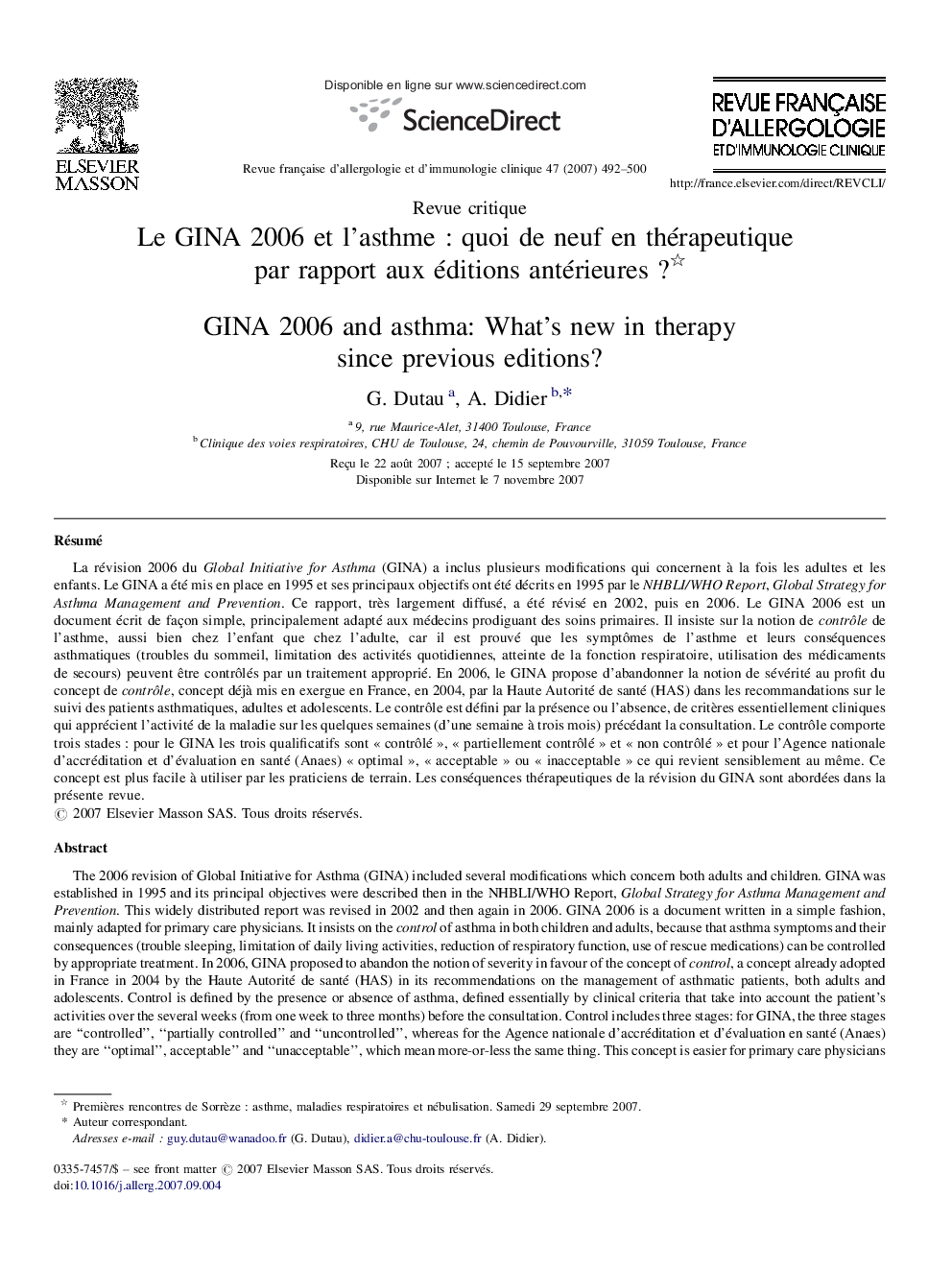| Article ID | Journal | Published Year | Pages | File Type |
|---|---|---|---|---|
| 2770253 | Revue Française d'Allergologie et d'Immunologie Clinique | 2007 | 9 Pages |
RésuméLa révision 2006 du Global Initiative for Asthma (GINA) a inclus plusieurs modifications qui concernent à la fois les adultes et les enfants. Le GINA a été mis en place en 1995 et ses principaux objectifs ont été décrits en 1995 par le NHBLI/WHO Report, Global Strategy for Asthma Management and Prevention. Ce rapport, très largement diffusé, a été révisé en 2002, puis en 2006. Le GINA 2006 est un document écrit de façon simple, principalement adapté aux médecins prodiguant des soins primaires. Il insiste sur la notion de contrôle de l’asthme, aussi bien chez l’enfant que chez l’adulte, car il est prouvé que les symptômes de l’asthme et leurs conséquences asthmatiques (troubles du sommeil, limitation des activités quotidiennes, atteinte de la fonction respiratoire, utilisation des médicaments de secours) peuvent être contrôlés par un traitement approprié. En 2006, le GINA propose d’abandonner la notion de sévérité au profit du concept de contrôle, concept déjà mis en exergue en France, en 2004, par la Haute Autorité de santé (HAS) dans les recommandations sur le suivi des patients asthmatiques, adultes et adolescents. Le contrôle est défini par la présence ou l’absence, de critères essentiellement cliniques qui apprécient l’activité de la maladie sur les quelques semaines (d’une semaine à trois mois) précédant la consultation. Le contrôle comporte trois stades : pour le GINA les trois qualificatifs sont « contrôlé », « partiellement contrôlé » et « non contrôlé » et pour l’Agence nationale d’accréditation et d’évaluation en santé (Anaes) « optimal », « acceptable » ou « inacceptable » ce qui revient sensiblement au même. Ce concept est plus facile à utiliser par les praticiens de terrain. Les conséquences thérapeutiques de la révision du GINA sont abordées dans la présente revue.
The 2006 revision of Global Initiative for Asthma (GINA) included several modifications which concern both adults and children. GINA was established in 1995 and its principal objectives were described then in the NHBLI/WHO Report, Global Strategy for Asthma Management and Prevention. This widely distributed report was revised in 2002 and then again in 2006. GINA 2006 is a document written in a simple fashion, mainly adapted for primary care physicians. It insists on the control of asthma in both children and adults, because that asthma symptoms and their consequences (trouble sleeping, limitation of daily living activities, reduction of respiratory function, use of rescue medications) can be controlled by appropriate treatment. In 2006, GINA proposed to abandon the notion of severity in favour of the concept of control, a concept already adopted in France in 2004 by the Haute Autorité de santé (HAS) in its recommendations on the management of asthmatic patients, both adults and adolescents. Control is defined by the presence or absence of asthma, defined essentially by clinical criteria that take into account the patient's activities over the several weeks (from one week to three months) before the consultation. Control includes three stages: for GINA, the three stages are “controlled”, “partially controlled” and “uncontrolled”, whereas for the Agence nationale d’accréditation et d’évaluation en santé (Anaes) they are “optimal”, acceptable” and “unacceptable”, which mean more-or-less the same thing. This concept is easier for primary care physicians to use. The therapeutic consequences of the GINA revisions will be considered in the present review.
